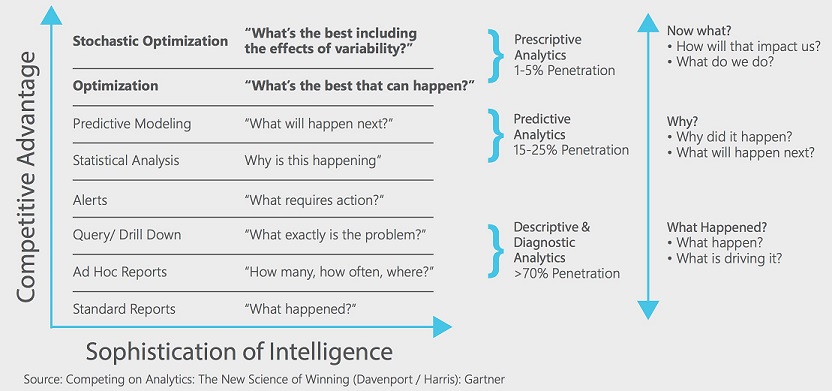Optimization and Operations Research have been around for the past 60-70 years, with their origin in World War II. However, in the past optimization has always been in the realm of specialist knowledge with a niche focus. It is only in the past few years that it has taken up a new avatar in the form of Prescriptive Analytics and started being taken seriously as a business user tool. The following Figure illustrates the evolution of different types of analytics and the realization that Prescriptive Analytics is the highest echelon in this hierarchy.

Figure 1. Prescriptive Analytics and its presence
in the hierarchy of analytics
What is the role of Optimization in Prescriptive
Analytics?
·
Optimization solvers use algorithms such as linear
programming, mixed integer programming, constraint programming and heuristic
algorithms to minimize or maximize some objective while meeting global business
constraints.
·
Optimization can tackle more complex problems by
making use of an explicit analytical decision model to compute the outcomes of
each alternative and evaluating trade-offs among multiple objectives and
constraints.
·
This analytical decision model explicitly computes
outcomes for each decision alternative, so one knows for every possible choice
what the expected outcomes are and, in the end, what the optimal decision is.
·
In other words,
Prescriptive Analytics is enabled by Optimization
Why has Prescriptive Analytics taken a business flavour in today’s environment?
The reason for the mainstream presence of
prescriptive analytics is the realization that business users are no longer
getting what they need from the basic Business Intelligence analytics of the
past. The advanced analytics marketspace has thus had to mould to this need,
making things like predictive and prescriptive analytics accessible and
digestible to the business user, not just to OR experts. Instead of
the need to write complication code and build complex models with long solve
times, the key technology requirements for the business user (and thus the
prescriptive analytics marketspace) look quite different than they did 5+ years
ago.
Some of these key requirements that have turned
prescriptive analytics into something used by a business user are as follows:
·
Ability to show compelling ROI – clear value add
over and above prior alternatives
·
Great user experience – easy to learn, easy to use.
Business users must be able to do the following quickly and easily to
get the full value of prescriptive analytics:
o
Develop, maintain and extend models
o
Input, prepare, visualize and edit input data
o
Visualize and compare scenarios
o
Ability for key users to configure their own
reports
·
Trustworthy business process – explicit,
collaborative. Things like input validation, process track / auditing and user
collaboration are a must in any tool that is being used (sometimes on a daily
basis) to create business plans, manage trade-offs and optimize decisions.
·
Agility – intelligent, fast. In today’s rapidly
changing environment, it’s crucial that prescriptive analytics allow users to
proactively identify problems - including comparison of actuals vs. plan — and
run rapid what-if scenarios.
True, Optimization has been around for a long time. However, with the rise of advanced analytics and the ever-increasing need to leverage data to improve decision making, it now has a new face - a face for the business user rather than the OR guru!
Contributed
by: Rod Stout, Business Modelling Associates (BMA). BMA is the official
distributor for River Logic’s Enterprise Optimizer® platform across Africa.